|
Fly of
the Month
Bob Ireton brings together his
experience in fly fishing, aquatic entomology, and knowledge of fly
tying techniques and materials, to design and tie durable and
effective flies.
|

|

Volume 5, Issue 2
February 2004

QUILL GORDON
Fly, Text, and Photography by Bob Ireton
The Quill Gordon is the most famous of the
traditional Catskill dry fly dressings. It was originated by Theodore
Gordon, father of American dry-fly fishing. The Catskill style, using
stiffer hackles than traditional dry flies, has been the most popular
dry-fly type on American waters for about a century. This fly nicely
captures the mayfly silhouette. More important, it perches on its hackle
points and tail fibers, giving the proper light impression on the water of
a mayfly dun drifting on the surface waiting for its wings to dry. In
brisk water, this light impression is the key that triggers trout to move
upward to take the fly.
MATERIALS
Hook - TMC 100, Dai-Riki 300,
Daiichi 1100, Mustad 94840, Orvis 1509, or standard dry fly hook.
Size - 12-16.
Thread - Black, 6/0 or 8/0.
Wings - Wood Duck flank feathers.
Tail - Dark blue dun hackle fibers.
Body - Stripped peacock herl quill.
Hackle - Dark blue dun dry fly hackle feather.
TYING STEPS - click on
pictures for larger view
| 1 - Place the hook properly
in the vice. Attach thread behind hook eye, leaving a space of one
hook eye between thread and eye. Lay on a thread base rearward,
stopping above hook barb. Then bring the thread forward with
well-spaced wraps, and stop at the wing tie in location. Tie a half
hitch. |
 |
|
2 - Select a nice wood duck flank feather.
Moisten the feather with water, and stroke the fibers from the base
towards the tip to make the fibers more manageable. Position the
feather on top of the hook with the tip extending past the hook eye.
Adjust the feather/thread position so the upright wing will be
approximately 1/4 hook shank distance behind the eye of hook, and the
wing as long as the length of the hook shank. Tie in with a couple of
soft loops, and make any final adjustments. Tighten loops, and make
several more tight loops. Cut off butt end of feather, and even up
thread wraps. Tie a half hitch. |
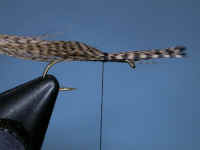 |
| 3 - Lift wings to an upright
position, and lock in this position with thread wraps. Divide the
fibers to form the wings using figure eight thread wraps. Bring thread
back above hook point area, and tie a half hitch. |
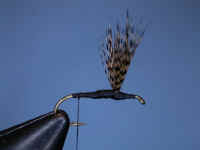 |
| 4 - Select some dun hackle
fibers, and adjust the fibers so the tips are even. Lay on top of hook
shank with the tips facing rearward. Tie in with a couple of soft
wraps. Adjust so length of tail is the length of the hook shank.
Tighten thread wraps, and add several more. Cut butt ends of fibers,
and tie a half hitch. |
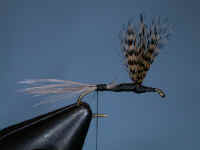 |
| 5 - Select a piece of
peacock herl. Lay it on a hard, flat surface, and using a rubber
eraser, rub against the lay of the fibers, and remove the fibers from
the quill. Now soak the quill in some warm water for a few minutes to
make the quill more flexible. Then tie the quill in above the tail.
Bring the thread forward, evening out the abdomen as you go. Tie a
half hitch behind the wing.
|
 |
| 6 - Palmer the quill forward
to form the abdomen. Tie off behind wing, and cut off excess. Tie a
half hitch. Bring thread forward of the wing.
|
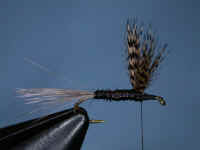 |
| 7 - Tie in the hackle
feather. Tie a half hitch. |
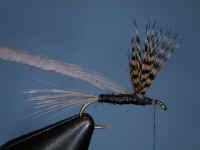 |
| 8 - Palmer the hackle
feather several wraps behind the wing, and several wraps in front of
the wing. A Catskill type fly has more hackle than a traditional style
dry fly. Tie off, and snip off excess feather. Form a head, tie a
couple of half hitches, and then a whip finish. Cut off the working
thread. Put some head cement on the thread. |
 |

www.buckeyeflyfishers.com
Site designed and maintained by
Panfalone@fuse.net
|

![]()
![]()
![]()







